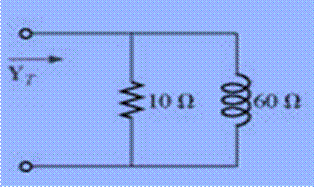
Introductory Circuit Analysis (13th Edition)
13th Edition
ISBN: 9780133923605
Author: Robert L. Boylestad
Publisher: PEARSON
expand_more
expand_more
format_list_bulleted
Concept explainers
Textbook Question
Chapter 16, Problem 4P
For each configuration of Fig. 16.66:
a. Find the total impedance in polar form.
b. Calculate the total admittance using the results of part (a).
c. Identify the conductance and susceptance parts of the total admittance.
d. Sketch the admittance diagram.

Fig. 16.66
Expert Solution & Answer
Trending nowThis is a popular solution!

Students have asked these similar questions
NO AI PLEASE SHOW WORK FOR ALL
NO AI PLEASE SHOW WORK
NO AI PLEASE SHOW WORK
Chapter 16 Solutions
Introductory Circuit Analysis (13th Edition)
Ch. 16 - Find the total impedance of the parallel networks...Ch. 16 - Find the total impedance of the parallel...Ch. 16 - Prob. 3PCh. 16 - For each configuration of Fig. 16.66: a. Find the...Ch. 16 - For each configuration of Fig. 16.67 a. Find the...Ch. 16 - For each network of Fig. 16.68: a. find the total...Ch. 16 - For the circuit of Fig. 16.69: a. Find the total...Ch. 16 - Given the voltage and current shown in Fig. 16.70,...Ch. 16 - For the network in Fig. 16.71: a. Find the total...Ch. 16 - Repeat Problem 9 for the network in Fig. 16.72,...
Ch. 16 - For the network of Fig. 16.73: a. Find the total...Ch. 16 - For the network in Fig. 16.74: a. Find the total...Ch. 16 - Repeat Problem 12 for the circuit in Fig. 16.75...Ch. 16 - Calculate the currents I1 and I2 in Fig. 16.76 in...Ch. 16 - For the parallel R-C network in Fig. 16.77: a....Ch. 16 - For the parallel R-L network in Fig. 16.78: a....Ch. 16 - Plot YTandT(ofYT=YTT) for a frequency range of...Ch. 16 - Plot YTandT(ofYT=YTT) for a frequency range of...Ch. 16 - For the parallel R-L-C network in Fig. 16.79. a....Ch. 16 - For the series circuits in Fig. 16.80, find a...Ch. 16 - For the parallel circuits in Fig. 16.81, find a...Ch. 16 - For the network in Fig. 16.82: a. Calculate E, IR,...Ch. 16 - Find the element or elements that must be in the...Ch. 16 - For the network in Fig. 16.13 (usef=1kHz): a....Ch. 16 - For the network in Fig. 16.32: a. Plot the...
Additional Engineering Textbook Solutions
Find more solutions based on key concepts
What are the design issues for character string types?
Concepts Of Programming Languages
How is the hydrodynamic entry length defined for flow in a pipe? Is the entry length longer in laminar or turbu...
Fluid Mechanics: Fundamentals and Applications
This optional Google account security feature sends you a message with a code that you must enter, in addition ...
SURVEY OF OPERATING SYSTEMS
1.2 Explain the difference between geodetic and plane
surveys,
Elementary Surveying: An Introduction To Geomatics (15th Edition)
What is an uninitialized variable?
Starting Out with Programming Logic and Design (5th Edition) (What's New in Computer Science)
What types of polymers are most commonly blow molded?
Degarmo's Materials And Processes In Manufacturing
Knowledge Booster
Learn more about
Need a deep-dive on the concept behind this application? Look no further. Learn more about this topic, electrical-engineering and related others by exploring similar questions and additional content below.Similar questions
- NO AI PLEASE SHOW WORKarrow_forwardConsider a Continuous- time LTI System. described by y' (+)+ nycH) = x(+) find yet for усн b) x(+) = u(+) Sul. a) x(+)= ētu(+). c) X(+= √(+) jw few) +2 kW) = X (w) (jw+2) Y(W)= X(w) Han Youn X(w) ½ztjuk a) X (W) = 1 + jw Y(W)= X(w) H(W). I tjw z+jw tjw = 1+jw 2+jw y (+) = (e+ - e²+) 4(+) b) XIW): π (W) + |/|/w Y₁W) = [π √(W) + 1/w] =² + j w zxjw How = π √(w) 1 ㅠ беш) 24jw + *= II 8 (W) + 1 1 1 1 2 4 jw = 2 y(+)= \uct) - e²+us+] - SINAALINE ju 2+ jwarrow_forwardNO AI PLEASE SHOW WORKarrow_forward
- Don't use ai to answer I will report you answerarrow_forwardCompute the Laplace transform of the following time domain function using only L.T. properties: f(t)=(t-3)eu(t-2) The Laplace Transform of x(t) = 8(-1) - u(1) is X(s): = (a) 2πδ(s) (b) 1-1 S (c) j2πδ (s) (d) - 1/3 Sarrow_forwardUf you don't know, don't attempt this questions,no Ai or it's screen shot should be usedarrow_forward
- Find the initial and final values of sequence x(n) from X(Z) below using the initial and final value properties X(Z) = = z-1arrow_forwardOnly expert should attempt,no Ai or screen shot it solving, I need solution s to all of themarrow_forwardDon't use ai to answer I will report you answerarrow_forward
- Find the autocorrelation function of the periodic function x(t) 1 0 1 2 3 tarrow_forwardFind Laplace transform for x(t) = e−³t √∞ (1 − t) sin(t − 2) §(t)dt Find Laplace transform and the corresponding ROC for x(t) = e˜³τsin(2t) u(t)dtarrow_forwardfind the inverse Laplace transform of X(s)=- s+5 (s-1)(s-2)(s-3) i) Re[s]> 3 ii) Re[s]<1 iii) 1arrow_forwardarrow_back_iosSEE MORE QUESTIONSarrow_forward_ios
Recommended textbooks for you

 Power System Analysis and Design (MindTap Course ...Electrical EngineeringISBN:9781305632134Author:J. Duncan Glover, Thomas Overbye, Mulukutla S. SarmaPublisher:Cengage Learning
Power System Analysis and Design (MindTap Course ...Electrical EngineeringISBN:9781305632134Author:J. Duncan Glover, Thomas Overbye, Mulukutla S. SarmaPublisher:Cengage Learning


Power System Analysis and Design (MindTap Course ...
Electrical Engineering
ISBN:9781305632134
Author:J. Duncan Glover, Thomas Overbye, Mulukutla S. Sarma
Publisher:Cengage Learning
Z Parameters - Impedance Parameters; Author: Electrical Engineering Authority;https://www.youtube.com/watch?v=qoD4AoNmySA;License: Standard Youtube License